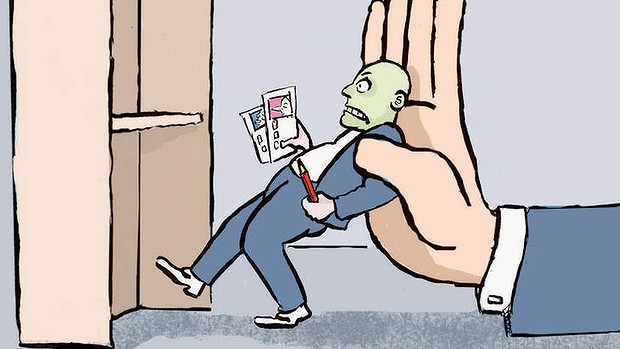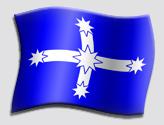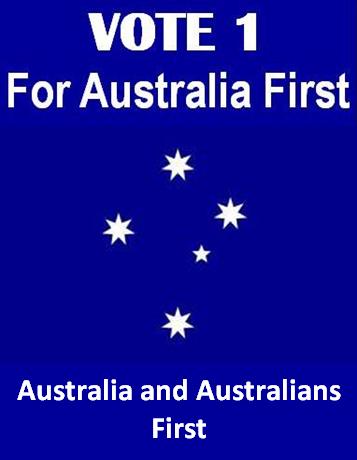Federal Campaigns Report
Captain Chaos Comes To The Polling Booth: Australia First Party In The Federal Election
The Federal election delivered chaos across the board for the major parties, and for ideological-message parties (such as our own) – but also raised up the issue of minor parties which tangled the process and sometimes evinced power beyond their size. For Australia First’s part, we wished we had done ‘better’ in vote terms, but it is more than obvious that many factors blocked us.
We must be analytical about the entire circus.
Note first, that when we participate in Federal elections, we join a process by the Establishment’s rules with the media manipulation of issues and focus and with our severe limitations of resources. It is only the foolish who reason that because we have a ‘good and true’ message that we will register electoral support. It is a fact that after the election only the foolish reason we have “failed” because our message (let alone our image) was not the right one and they set off on a permanent quest to find the solution to make themselves palatable to the voters. That psychological swamp of wishful delusion is forever the bane of smaller parties – although hopefully never our own.
As we say, Australia First Party is not here for the voters, it is here for the Australian People and a historical cause (the cause of National Identity and Independence) and if the party builds in the community as a community based movement of action and dissent, it will ultimately develop into a mass movement. We are obliged to participate in elections to build resources and profile and to legitimize ourselves as a movement of rational dissent. Yet, we are not an electoral party. That distinction has confused some of our critics and would-be competitors, but it remains the key to forever avoid isolation and to expand our power. This report will suggest that our participation in the election, based as it was upon our community strategy, delivered to us some positive results.
Some of the chaos discussed
Captain Chaos came to the polls on September 7 and delivered peculiar results. It is important for nationalists to review the macro and micro picture and assimilate useful data and appropriate lessons.
We note that up to possibly 1.5 million Australians simply refused to turn up to vote and that 5% voted informal – some deliberately.
These events are protests of a low-level sort at lack of empowerment. Well might we argue that many of these people are our lost voters, but more importantly, many may be our followers at the community level where we can actually mobilise some of them. Their refusal to participate in a circus is not unproductive and is the start of a real politics, even if it has negative electoral ramifications.
Humour is found in that one in seven of the Liberal Party’s voters in New South Wales voted by mistake for a party with a similar name – the Liberal Democratic Party – which was at the top of the Senate ticket. The LDP was a master of crookery and had registered over the last three years three or four different sounding parties to ‘preference’ them (Smokers Rights, Stop The Greens, the Republicans). It was the LDP that ultimately blocked Pauline Hanson’s preference-swap-path to the Senate and it will most likely elect its representative instead.
The chaos in the Senate preferencing system caused by ‘registered how to vote cards’ (ie. one votes with a 1 above the line and finds his vote given to some other party by covert preference arrangement) will almost certainly not operate at the next Senate election – or so says Senator Ron Boswell, Senator Nick Xenophon and innumerable other politicians and commentators. We believe them, given that the Senate may see candidates elected on a couple of thousand primary votes, making a fair mockery of the system.
This also means that the ‘small parties alliance’ which came into being months ago to allow small parties to preference each other ahead of ‘majors’ (Australia First Party joined it) would have to undergo big changes, particularly too after many of the parties are probably deregistered. Given preferencing will probably become optional in the Senate in some way or other, preference deals would be more in the open and verifiable by those who entered into them and operated by how to vote cards actually handed out and through advertising which advises the voters how to vote. Of course, a small parties’ alliance as such is also a fiction given the vastly different nature of the groups. Being united by an aversion to major parties is no real basis for any sort of unity. However, some of the parties do share some common ground and can reach agreements. We are pleased to say that our party’s Registered Officer Tony Pettitt did manage to build some rapport with some smaller parties which may allow fair and proper ‘deals’ in the future.
It is likely too that party registration requirements will become more stringent and we must be ready for that.
The Stable Population Party fizzled – despite the support of Dick Smith. Careful to preference Australia First Party second last just ahead of One Nation, the party believed no one would dare shout racist (sic) at it after such a forthright and mainstream act. Well, bad luck. We outpolled them in the Senate in both New South Wales and Queensland and Mick Saunders outpolled them in Lindsay where their candidate was also a well known community activist. It seems the ‘racists’ (sic) outnumber the gutless. While Stable Population has many useful arguments, it had no profile. It may be that Australia First Party should further move onto its environmentalist ground on the matter of immigration – and subsume that sector of support.
The matter of One Nation has been important for us as it seems we fight with them over some shared territory. Australia First Party’s small House of Representatives’ seat votes were larger than those of One Nation in Queensland, but somewhat smaller than One Nation in New South Wales where ON benefitted from the Hanson publicity factor.
One Nation in the Queensland Senate will have half the votes of last time, despite Hanson’s ‘return’. Their vote collapsed in Victoria (where it is a few hundreds) and South Australia and Western Australia returns were dismal indeed.
Pauline Hanson has failed to make it into the NSW Senate. Some pundits within the One Nation camp say it is all over for that party and over for Pauline Hanson too. That is probably the case although the party will stay registered until sometime next year. The eclipse of Pauline Hanson was reflected in the fact that she polled some 100,000 votes for the NSW upper-house in 2011, but will reach just over half that now. It seems even celebrity status and a healthy dose of behind-the-scenes preference-swap wheeling and dealing cannot help the inevitable. She will pass from the scene.
One Nation was always suggesting it is more ‘mainstream’ (as if that is any endorsement) than Australia First and a better bet for patriotic people. However, One Nation had also officially abandoned nationalist positions on immigration and refugees, favouring the multiracial society with ‘assimilation’) and the admission to Australia of legal (sic) refugees. It might be a pleasant thing to be the last horse in the political paddock, because it allows serious political building with some genuine nationalists finally draining out from the One Nation pool.
We endured One Nation spite in New South Wales where they split votes on us in Lindsay and Chifley. That was deliberate and malicious. The failure of Pauline Hanson to win her race wipes that dirty side-swiping – very clean indeed.
The Katter’s Australian Party (KAP) essentially collapsed. It is unlikely Katter can re-craft it. All that hype about how it’d become the big third force in Australian electoral politics summed to pretty much zero. In the Riverina and in Calare, we outpolled them and Katter himself almost lost his seat and survived only on Labor preferences. In Queensland, Clive Palmer’s United Party – surged past him. Hopefully, some of the good ground Katter farmed (foreign imports / agricultural protection) might eventually pass to Australia First Party. It was positive too that Katter’s attempt to project his party as some sort of dinkum patriotic party was exposed during the campaign. Katter’s plans for an Asian food bowl in the north of Australia puts him pretty much in the camp of Liberal and Labor who would detach the north of our country into a Capricornia Zone peopled by new immigrants, refugees and contract labourers.
The extreme Left wing vote also shrank, but that’s not surprising. The Left need only be considered a street danger to our party as we grow at the community level.
The big surprise was the Palmer United Party, another Liberal Party of sorts that stymied Katter and polluted the protest-vote market. It is clear that many Australians cannot distinguish a new ‘brand’ from a new ‘product’. Rumours have it that Palmer spent $10,000,000 overall. Even so, all that money only brought him just under 5% of the national Senate vote. That point might be something for us to think about. If high profile and $10,000,000 only brings 5% of the vote, then ….???
Refreshingly too, the Liberals, Labor and the Greens preferenced us last or second last. Such an honour!
What votes did we receive?
The massive number of candidates in both Houses confused the vote absolutely and contributed to most message-parties doing poorly. In areas where we wanted to do well, the ticket was bulging. There is no doubt this depressed our vote and it informs us as to our electoral difficulties in projecting ourselves beyond the pack. Our votes in the House of Representatives (there may be some variation as remaining postal votes are counted) are as follows:
As below, the final figures:
Our votes in the House of Representatives are as follows (September 26):
Bennelong: 492
Calare: 1010
Chifley: 396
Cook: 617
Deakin: 212
Lindsay: 610
Macquarie: 750
Newcastle: 922
Port Adelaide: 1116
Riverina: 1,287
The total of 7412 averages at 741 per seat – less than 1%. We would say loudly that this result does not reflect our actual level of electoral support because of our lack of polling booth labour.
At many booths with our polling workers in attendance with how to vote cards, we passed 2%. Even so, and given that tiny caveat, we could only estimate our real national voting clientele in this election – as somewhere between 100,000 and 150,000.
Fair enough, even if it is fringe stuff. All movements of national renewal start there. It is clear to us from responses at the booths that those voting for us were determined and younger. That bodes very well for the future, electorally and otherwise.
Our Senate results reflected the large number of parties and the surge in Liberal Party support and so on and are not used here as part of our calculation of electoral support.
It has been noted by several leading members and candidates that Australia First Party has done better at the local government level than elsewhere. Naturally. That is where our nationalist politics are localised and we operate on a playing field of a more ‘level’ nature. Further, our community activist politics means that we are perceived as defenders of people’s interests. We are certain to go further down that road. In the next Council by election, anywhere in the country in the near future, we will do much better than our Federal results.
Where did our votes go?
The party initially entered the election race with a simple strategy. Other than the obvious efforts at profile-raising and the recruitment of new members, we would thence initially focus on only a few seats and the Queensland Senate. It was thought that the huge expected ‘swing’ against the unpopular Labor Party under Julia Gillard would produce a different sort of electorate for us. It was considered that Australia First Party could obtain public funding. On these bases, the number of seats of interest eventually increased. Of course, the terrain changed with the change steady growth of the Palmer United Party, the re-emergence of Pauline Hanson and then the change in Prime Ministers.
From that time on, Australia First Party was simply fighting for profile and new members. Indeed, we added two more seats to our bag. It was considered appropriate that we stay in the contest in all the seats then receiving our attention.
Any analysis of the figures shows that the votes in most areas and in the Senate for parties like the Shooters And Fishers, the Christian Democrats and One Nation – declined. The latter increased over the 2010 result in NSW – only because of Pauline Hanson’s presence even if it was half her score of 2011 (as discussed). An array of other minor parties soaked up votes everywhere – and there was the huge swing to the Liberals. In our case, it is fair to conclude that the Katter and Palmer parties took the rest of the pool.
Against these factors, it is clear that Australia First Party’s vote scores could not be great.
What did Australia First Party achieve through participation in the election?
Australia First Party candidates and activists have broadened their political experience in many ways. They have established new contacts in the community. In some cases, like Newcastle and Port Adelaide seeds for the future have been planted there with the party highlighting important local issues related to the folly of globalism.
However, more than the new members and supporters whom we have also acquired, it is the sheer profile building of the party that has been impressive. A number of radio stations broadcast our spokesmen as did internet television productions. We appeared in at least forty local papers many times and in large stories and we received many mentions in national and international media over the Wikileaks Party preference deal.
Most of this was balanced stuff and shorn of the usual hysteria with which the party is usually met with in the national media. The attendance of candidates at candidate-forums was useful and it led to the development of better relations with other groups and local people. This was the experience of Mick Saunders in Lindsay. The party is now better known than at any other time in its history. This can be built upon. Some members say that the party has a type of subterranean recognition factor because its message and data about it travels along pathways outside of national media. Perhaps so.
In the rough and tumble of the election process, we have exposed some real or more-or-less competitors and seen off others and sit ready to move on with near hegemonic control over our market. That is always an important starting point for a party with a historical and crucial message.
We have learned many practical lessons from the need for the scrutineering of votes to ensuring our members are appropriately equipped with the necessary equipment (we did better there than previously). Although we had reasons for our ‘strategy’ in this year’s poll, we may do much better to concentrate resources and not be swayed to experiment next time. We benefitted too from high visibility signs and trucks and utility signage which drew some public sympathy. We did well to involve many people in the production of electorate policy and written materials.
Although our party develops ‘electorate policy’ in accordance with its Core Policies and its Programme, any electoral success is contingent on a continuous community activism. The latter was clear in Riverina where we have led popular resistance to the Chinese Trade Centre, been active on the matter of foreign agricultural imports and vocal in our opposition to the refugee intrusion. It was certainly the agitational style of our candidate Lorraine Sharp, outside of even the election process that delivered our best result.
And lastly….
The party can only thank its financial contributors, its organizers, its candidates and its many activists who worked hard. They were magnificent. We can thank people from other organisations who helped us.
Our candidates are now well known and deserve special thanks: Peter Scuback, Peter Watson, Darrell Wallbridge, Garth Fraser, Victor Waterson, Peter Schultze, Alex Norwick, Jim Saleam, John Carbonari, Mick Saunders, Matt Hodgson, Michael Chehoff, Terry Cooksley and Lorraine Sharp.
Our candidate for Calare, Peter Schultze, 27, summed it well when he concluded that he had time and experience against him, but he set out to encourage to come forward some decent local people and to put over his message. He said he was disappointed with his vote score but somehow half expected it. He found his attention to local issues (in the context of the national problems) stood him in good stead and he was reported accurately. Peter survives to fight another day.
And there will be another day as Australia First Party builds in the community its influence and its support.
Our Campaigns
Bennelong 2013
Calare 2013
Chifley 2013
Cook 2013
Deakin 2013
Lindsay 2013
Macquarie 2013
Newcastle 2013
Port Adelaide 2013
Riverina 2013
Senate NSW 2013
Senate QLD 2013



